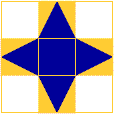Next, I cut a piece of Solvy to fit the quilt top. You only need to go to the edges and a touch over. Anything beyond that is wasted.

You are going to use the Solvy to hold the layer of fibres and yarns in place while you machine quilt the quilt top. Secure the Solvy in place with safety pins. Pin it as you would any top you were going to machine quilt.
As you do the edges, try to tuck in any stray fibres or yarns. Anything that sticks out will be cut off later.
 Now, you have to machine quilt this top to death. The machine quilting has to hold the wool fibres and the yarns in place for ever, so now is not the time to scrimp on the quilting. I used a purple variegated cotton on the purple parts and an orange variegated cotton on the orange part.
Now, you have to machine quilt this top to death. The machine quilting has to hold the wool fibres and the yarns in place for ever, so now is not the time to scrimp on the quilting. I used a purple variegated cotton on the purple parts and an orange variegated cotton on the orange part.If I'd made the bottom layer bigger on the top and bottom, it would have been easier to machine quilt the edges and corners. Oh, well, something to remember for next time.
 It isn't always easy to tell from the front if you've quilt it enough, so I always check the back to be sure.
It isn't always easy to tell from the front if you've quilt it enough, so I always check the back to be sure.
There are a couple of spots that need more quilting.

 Because it's hard to see on the front, I marked the spots with pins.
Because it's hard to see on the front, I marked the spots with pins.
 Then, I machine quilted the areas marked with pins and did more in the centre. I never quilt enough when I first start so usually have to go back over that area again.
Then, I machine quilted the areas marked with pins and did more in the centre. I never quilt enough when I first start so usually have to go back over that area again. As you can see, there isn't anything fancy about the machine quilting I did. The purpose of the machine stitching is to hold the fibres and yarns in place and the interlocking circles works a treat. For this quilt, the machine quilting adds texture to the piece but doesn't show up like it does when you are machine quilting a normal pieced quilt top.
As you can see, there isn't anything fancy about the machine quilting I did. The purpose of the machine stitching is to hold the fibres and yarns in place and the interlocking circles works a treat. For this quilt, the machine quilting adds texture to the piece but doesn't show up like it does when you are machine quilting a normal pieced quilt top.Step 4: Washing the Finished Quilt
I didn't take any photos of this step because that would have been silly. I filled the kitchen sink with cold water and dunked the top in. I used my fingers to rub the Solvy off the top, but it had pretty much dissolved all by itself.
I ran the top under running water and wrung it out. Yes, I wrung it out just like you would a face washer. Now, don't get all girly on me. This thing is pretty sturdy and it can stand up to that kind of treatment.
I also rolled it up in a towel and wrung it out again. The felt layer will hold a lot of water and the piece will dry a lot faster if you get as much water out as you can.
Next Post: The finished product.







1 comment:
Maggie - the photos in part two didn't upload but I love your step by step
Post a Comment